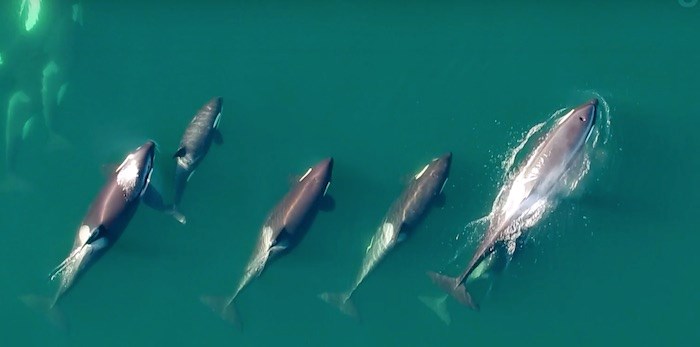 UBC researchers are using drones to capture footage of whales off the coast of B.C. Screenshot/YouTube via UBC News
UBC researchers are using drones to capture footage of whales off the coast of B.C. Screenshot/YouTube via UBC News
VANCOUVER — A University of British Columbia scientist says he was delightedly caught off guard when he spotted a southern resident killer whale calf appearing to use a fish as her teething ring and swimming with her mother this summer.
"We saw this female calf with its mom and what really caught my attention is that on the two days we saw her, she had a fish in her mouth," said Andrew Trites in an interview Monday.
Trites led a team of scientists over three weeks in August and September monitoring pods of southern and northern resident killer whales in the Salish Sea and off the central coast of B.C. The team is using aerial drones and sonar to study whether endangered southern residents are getting enough of their preferred prey, chinook salmon.
He said the calf holding a fish in her mouth was about three months old and they only drink milk at that age.
"Whether or not the calf was teething or learning to be just like mom ... these are some of the things that we observed and we talk about, and wonder and speculate on, and helps us get a bigger and more complete picture of the lives of these whales."
The scientists are comparing the eating habits of the southern and northern resident killer whales.
Like southern residents, the northern whales feed primarily on chinook and chum salmon and face many similar threats from water and noise pollution, increased shipping traffic and reduced abundance of food, Trites said.
But unlike their southern counterparts the northern population has increased significantly, he added.
The southern resident killer whales number 73 while their northern counterparts stand at about 300.
So, one of the things scientists want to compare is which of these mammals has better habitat in terms of food.
"Are they getting enough fish to know where are the fish? How many are there? Are they deep, are they shallow, far from shore, near to shore?" Trites asked.
"And we have to get all this information to answer the question: Are there enough fish here for the southern resident killer whales?"
Mei Sato, a research associate who is using sonar equipment similar to that used by fishing boats, is helping scientists figure out how the dinner plate for killer whales is set.
Initial results show deeper waters hold bigger fish, she said.
But Trites said whales expend greater amounts of energy when they dive into deep waters to get their meals.
Another question that scientists are looking to answer is why the orcas are not frequenting the areas around the Salish Sea and San Juan Islands.
Trites said that for the last three years the southern residents have not come back to the Salish Sea as often as they used to in spite of there appearing to be plenty of fish this year.
On their trip, Trites and his team observed southern residents in the Salish Sea where they were catching fish, breaching and indulging in social behaviour that suggested that they were feeling pretty good, he said.
"But then they left. They didn't stay. That was surprising," he said.
The scientists have a theory.
The killer whales may be running a trapline, he said.
"Maybe a little bit like a hummingbird where you put your feeder out and the bird doesn't guard it all summer," he said. "The bird comes and takes a few sips and goes somewhere else."
The orcas' trapline could run from Â鶹´«Ã½Ó³»Island all the way down to California, he said.
Another explanation could be linked to the death of the oldest female of the group, also known as Granny, almost four years ago, Trites said.
Granny would lead her pod to the Salish Sea to feed all summer but after her death, her daughters may have decided they would summer elsewhere, he said.
"It's possible that this summer in particular it's not that something was wrong here but something was much better elsewhere," Trites said.
"There's a story here and our job as scientists is to piece that story together."
Scientists want to go back on the waters again next summer to collect more data.
But they hope to analyze the data they have by spring next year to build a comprehensive picture of resident killer whale feeding behaviour to inform conservation and recovery efforts, he said.
Trites said another observation that pleasantly surprised scientists was the social nature of the whales.
"We watched mothers and their calves play together. And you see a mother with her two or three-year-old and her calf is whacking its mother with its tail and the mother is pushing it," he said.
"And I hadn't appreciated, as a scientist, how tactile the animals were. Touch ... is so important to killer whales. And I hadn't appreciated that until I sat on the ship and saw this for the first time."
This report by The Canadian Press was first published Nov. 4, 2019.
![]()


